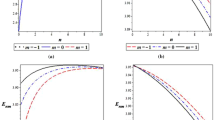Abstract
Applicability of the extended Nikiforov–Uvarov method in order to obtain eigenstate solutions of the radial Schrödinger equation in the presence of external magnetic field and Aharonov–Bohm (AB) flux fields is investigated. This study includes two analytical solutions of two different physical problems: solution of the non-relativistic wave equation for radial scalar power potential and solution for a charged particle with position-dependent mass interacted via Morse plus Coulomb potential under the influence of external magnetic field and AB flux fields. Wave function solutions for each case are achieved in terms of biconfluent Heun polynomials.
Similar content being viewed by others
References
A.V. Nikiforov, V.B. Uvarov, Special Functions of Mathematical Physics (Birkhauser, Boston, 1988)
M.R. Pahlavani, Theoretical Concepts of Quantum Mechanics (Rijeka, Croatia, 2012)
H. Egrifes, D. Demirhan, F. Buyukkilic, Phys. Scr. 59, 90 (1999)
F. Iacob, M. Lute, J. Math. Phys. 56, 121501 (2015)
H. Karayer, D. Demirhan, F. Buyukkilic, J. Math. Phys. 56, 063504 (2015)
H. Karayer, D. Demirhan, F. Buyukkilic, Rep. Math. Phys. 76, 271–281 (2015)
A. Ronveaux, Heun’s Differential Equations (Oxford University Press, New York, 1995)
S. Bellucci, V. Yeghikyan, J. Math. Phys. 54, 082103 (2013)
W.D. Li, W.S. Dai, Ann. Phys. 373, 207–215 (2016)
E.M. Ovsiyuk, O. Veka, M. Amirfachrian, Nonlinear Phenom. Complex Syst. 373, 2 (2012)
Y.Z. Zhang, J. Phys. A Math. Theor. 45, 065206 (2012)
C.A. Downing, J. Math. Phys. 54, 072101 (2013)
F. Caruso, J. Martins, V. Oguri, Ann. Phys. 347, 130 (2014)
H. Karayer, D. Demirhan, F. Buyukkilic, J. Math. Phys. 59, 053501 (2018)
M. Eshghi, H. Mehreban, Eur. Phys. J. Plus 132, 121 (2017)
S.M. Ikhdair, B.J. Falaye, M. Hamzavi, Ann. Phys. 353, 282–298 (2015)
H.R. Christiansen, M.S. Cunha, J. Math. Phys. 54, 122108 (2013)
S.M. Ikhdair, M. Hamzavi, Physica B Condens. Matter 407(21), 4198–4207 (2012)
M. Eshghi, H. Mehreban, S.M. Ikhdair, Chin. Phys. B 26(6), 060302 (2017)
D. Yu, P. Ghosh, R.Q. Snurr, Dalton Trans. 41, 3962 (2012)
H. Karayer, Eur. Phys. J. Plus 134, 452 (2019)
Acknowledgements
This work has been supported by The Scientific and Technological Research Council of Turkey with the Grant Number 118F245.
Author information
Authors and Affiliations
Corresponding author
Appendix: Extended Nikiforov–Uvarov method
Appendix: Extended Nikiforov–Uvarov method
In order to expand number of soluble potentials for relativistic or non-relativistic wave equations, the boundary conditions of the NU method are changed and extended form of the NU method is derived [5]. Thereby a second-order differential equation which has at most four singular points can be solved analytically by using extended NU method. To apply the extended NU method, one writes any second-order differential equation in the generalized form namely the basic equation of the method:
where the subscript ex stands for extended. The coefficients in the basic equation must have certain degrees namely \({\widetilde{\tau }}_\mathrm{ex}(z)\) is a polynomial of at most second degree, \(\sigma _\mathrm{ex}(z)\) is a polynomial of at most third degree and \({\widetilde{\sigma }}_\mathrm{ex}(z)\) is a polynomial of at most fourth degree [5, 6, 14, 21]. To find the particular solution of the basic equation, Eq. (45) is reduced to the following differential equation:
by using the transformation:
Equation (46) has a particular polynomial solution of the form \( y(z)=y_{n}(z) \) and the function \(\phi _\mathrm{ex}(z)\) is given as a logarithmic derivative:
The polynomials \(\tau _\mathrm{ex}(z)\), \(\pi _\mathrm{ex}(z)\) and h(z) arising in the procedure of reducing the basic equation of the method to Eq. (46) are defined as:
According to the condition that the polynomial \(\pi _\mathrm{ex}(z)\) is at most second degree, the polynomial g(z) must be chosen properly. After determination of the polynomial g(z), all newly defined polynomials can be achieved by using Eqs. (50), (51) and (49). Eigenvalue equation can be set up by taking:
where \(C_{n}\) is an integration constant.
Rights and permissions
About this article
Cite this article
Karayer, H. Study of the radial Schrödinger equation with external magnetic and AB flux fields by the extended Nikiforov–Uvarov method. Eur. Phys. J. Plus 135, 70 (2020). https://doi.org/10.1140/epjp/s13360-020-00131-2
Received:
Accepted:
Published:
DOI: https://doi.org/10.1140/epjp/s13360-020-00131-2



